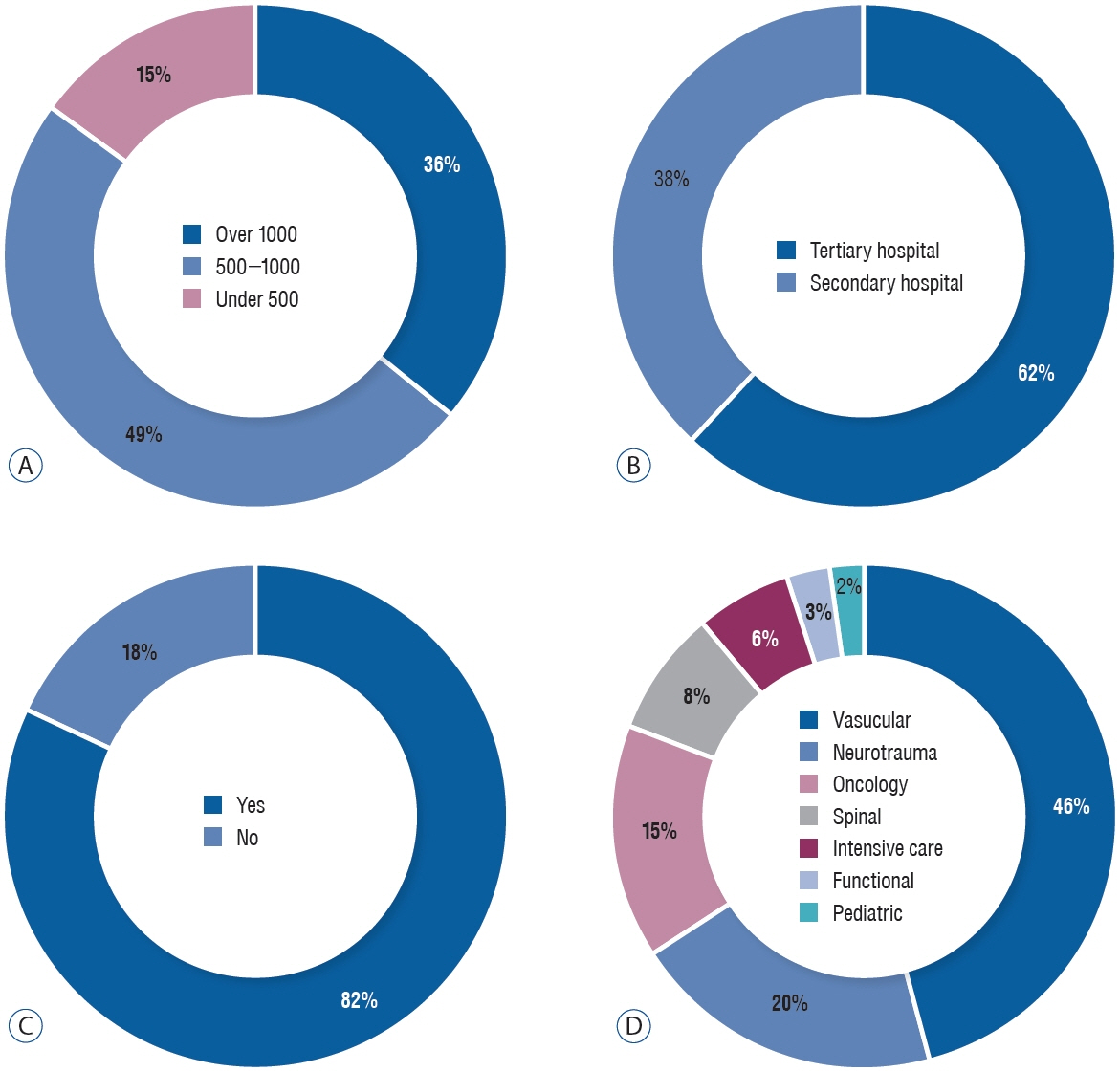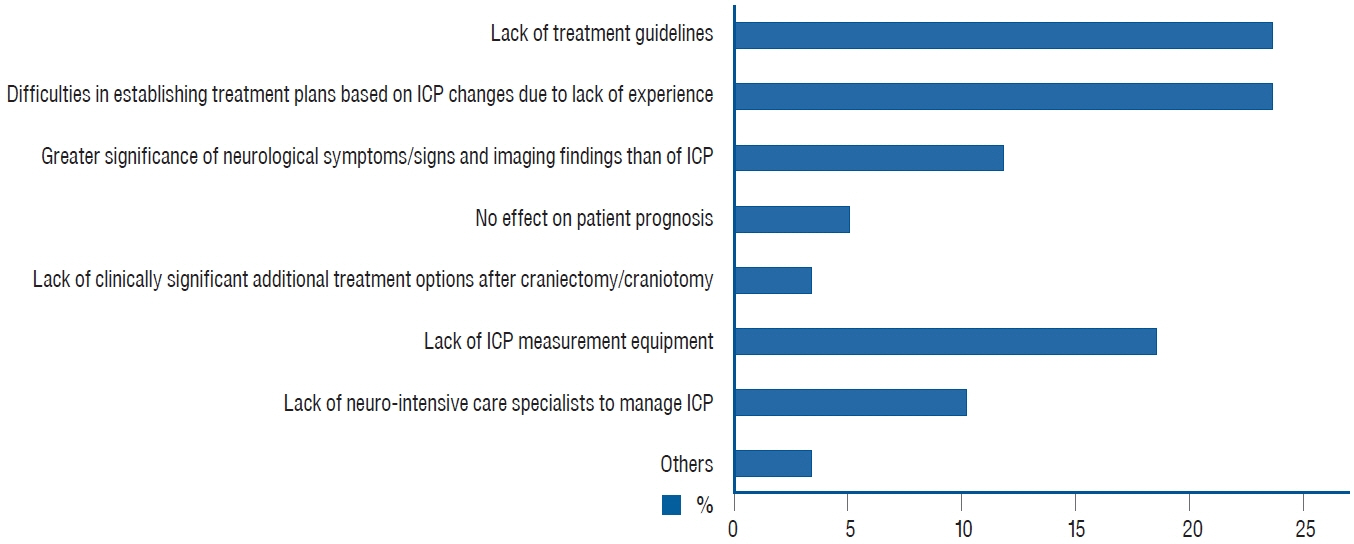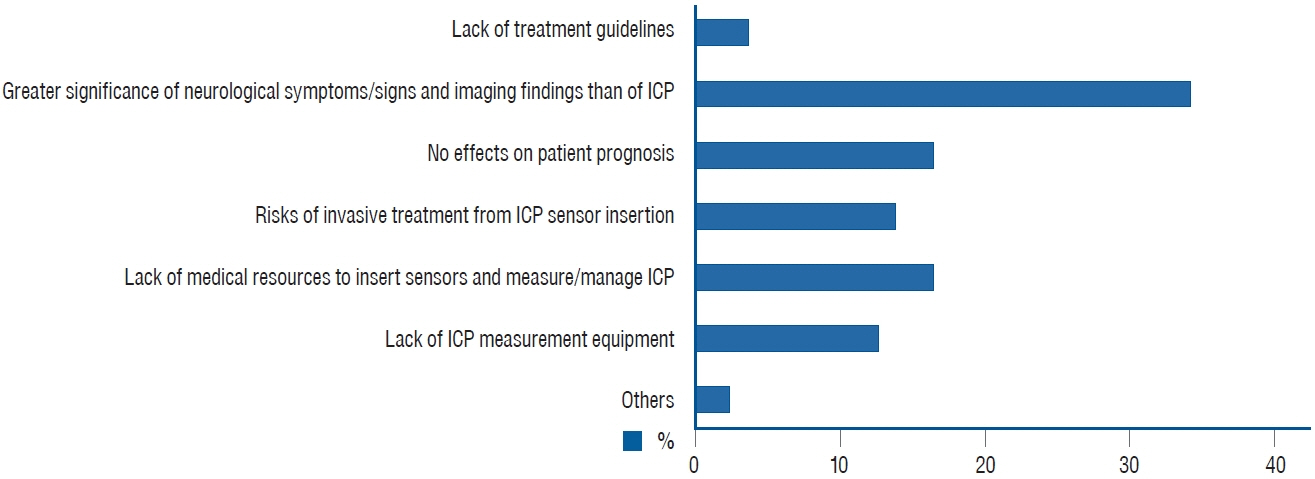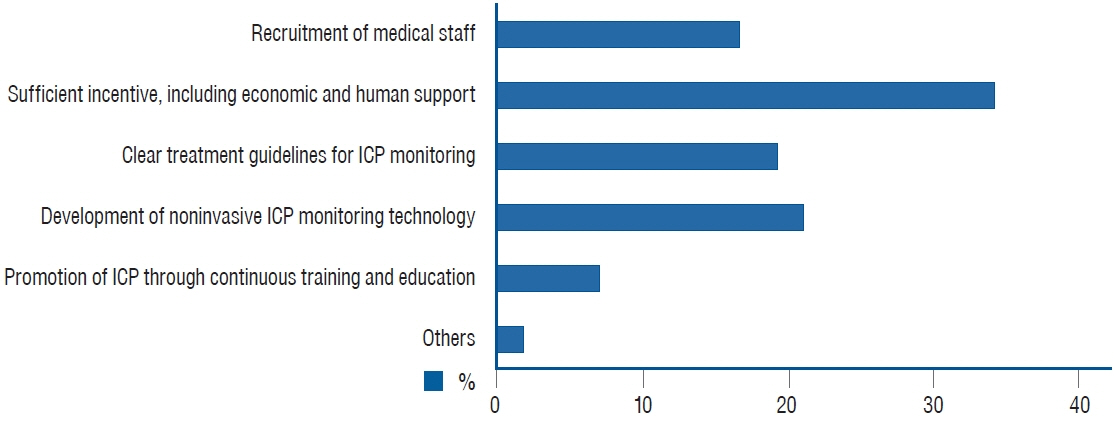J Korean Neurosurg Soc.
2023 Aug;66(5):543-551. 10.3340/jkns.2023.0019.
Current Status of Intracranial Pressure Monitoring in Patients with Severe Traumatic Brain Injury in Korea : A Post Hoc Analysis of Korea Neurotrauma Databank Project with a Nationwide Survey
- Affiliations
-
- 1Department of Neurosurgery, Medical Research Institute, Pusan National University Hospital, Busan, Korea
- 2Department of Neurosurgery, Yeouido St. Mary's Hospital, College of Medicine, The Catholic University of Korea, Seoul, Korea
- 3Korea Neuro-Trauma Data Bank Committee, Korea Neurotraumatology Society, Seoul, Korea
- KMID: 2545345
- DOI: http://doi.org/10.3340/jkns.2023.0019
Abstract
Objective
: This study aimed to investigate the current status of intracranial pressure (ICP) monitoring in patients with severe traumatic brain injury (sTBI) in Korea and the association between ICP monitoring and prognosis. In addition, a survey was administered to Korean neurosurgeons to investigate the perception of ICP monitoring in patients with sTBI.
Methods
: This study used data from the second Korea Neurotrauma Databank. Among the enrolled patients with sTBI, the following available clinical data were analyzed in 912 patients : Glasgow coma scale score on admission, ICP monitoring, mortality, and extended Glasgow outcome scale score at 6 months. In addition, we administered a survey, entitled “current status and perception of ICP monitoring in Korean patients with sTBI” to 399 neurosurgeons who were interested in traumatic brain injury.
Results
: Among the 912 patients, 79 patients (8.7%) underwent ICP monitoring. The mortality and favorable outcome were compared between the groups with and without ICP monitoring, and no statistically significant results were found. Regarding the survey, there were 61 respondents. Among them, 70.4% of neurosurgeons responded negatively to performing ICP monitoring after craniectomy/craniotomy, while 96.7% of neurosurgeons responded negatively to performing ICP monitoring when craniectomy/ craniotomy was not conducted. The reasons why ICP monitoring was not performed were investigated, and most respondents answered that there were no actual guidelines or experiences with post-operative ICP monitoring for craniectomy/craniotomy. However, in cases wherein craniectomy/craniotomy was not performed, most respondents answered that ICP monitoring was not helpful, as other signs were comparatively more important.
Conclusion
: The proportion of performing ICP monitoring in patients with sTBI was low in Korea. The outcome and mortality were compared between the patient groups with and without ICP monitoring, and no statistically significant differences were noted in prognosis between these groups. Further, the survey showed that ICP monitoring in patients with sTBI was somewhat negatively recognized in Korea.
Keyword
Figure
Reference
-
References
1. Agrawal D, Raghavendran K, Schaubel DE, Mishra MC, Rajajee V. A propensity score analysis of the impact of invasive intracranial pressure monitoring on outcomes after severe traumatic brain injury. J Neurotrauma. 33:853–858. 2016.2. Aiolfi A, Benjamin E, Khor D, Inaba K, Lam L, Demetriades D. Brain trauma foundation guidelines for intracranial pressure monitoring: compliance and effect on outcome. World J Surg. 41:1543–1549. 2017.3. Alali AS, Fowler RA, Mainprize TG, Scales DC, Kiss A, de Mestral C, et al. Intracranial pressure monitoring in severe traumatic brain injury: results from the American College of Surgeons Trauma Quality Improvement Program. J Neurotrauma. 30:1737–1746. 2013.4. Chesnut RM, Temkin N, Carney N, Dikmen S, Rondina C, Videtta W, et al. A trial of intracranial-pressure monitoring in traumatic brain injury. N Engl J Med. 367:2471–2481. 2012.5. Cremer OL, van Dijk GW, van Wensen E, Brekelmans GJ, Moons KG, Leenen LP, et al. Effect of intracranial pressure monitoring and targeted intensive care on functional outcome after severe head injury. Crit Care Med. 33:2207–2213. 2005.6. Dawes AJ, Sacks GD, Cryer HG, Gruen JP, Preston C, Gorospe D, et al. Compliance with evidence-based guidelines and interhospital variation in mortality for patients with severe traumatic brain injury. JAMA Surg. 150:965–972. 2015.7. Dawes AJ, Sacks GD, Cryer HG, Gruen JP, Preston C, Gorospe D, et al. Intracranial pressure monitoring and inpatient mortality in severe traumatic brain injury: a propensity score-matched analysis. J Trauma Acute Care Surg. 78:492–501. discussion 501-502. 2015.8. Eom KS; KNTDB Investigators. Epidemiology and outcomes of traumatic brain injury in elderly population : a multicenter analysis using Korean Neuro-Trauma Data Bank System 2010-2014. J Korean Neurosurg Soc. 62:243–255. 2019.9. Farahvar A, Gerber LM, Chiu YL, Carney N, Härtl R, Ghajar J. Increased mortality in patients with severe traumatic brain injury treated without intracranial pressure monitoring. J Neurosurg. 117:729–734. 2012.10. Gerber LM, Chiu YL, Carney N, Härtl R, Ghajar J. Marked reduction in mortality in patients with severe traumatic brain injury. J Neurosurg. 119:1583–1590. 2013.11. Haddad S, Aldawood AS, Alferayan A, Russell NA, Tamim HM, Arabi YM. Relationship between intracranial pressure monitoring and outcomes in severe traumatic brain injury patients. Anaesth Intensive Care. 39:1043–1050. 2011.12. He J, Chen J, Wu T, Zhang C, Yang L, Shi ZH, et al. The value of managing severe traumatic brain injury during the perioperative period using intracranial pressure monitoring. J Craniofac Surg. 30:2217–2223. 2019.13. Lane PL, Skoretz TG, Doig G, Girotti MJ. Intracranial pressure monitoring and outcomes after traumatic brain injury. Can J Surg. 43:442–448. 2000.14. Maas AIR, Menon DK, Adelson PD, Andelic N, Bell MJ, Belli A, et al. Traumatic brain injury: integrated approaches to improve prevention, clinical care, and research. Lancet Neurol. 16:987–1048. 2017.15. Mouchtouris N, Turpin J, Chalouhi N, Al Saiegh F, Theofanis T, Das S, et al. Statewide trends in intracranial pressure monitor use in 36,915 patients with severe traumatic brain injury in a mature trauma system over the past 18 years. World Neurosurg. 130:e166–e171. 2019.16. Okazaki T, Kawakita K, Kuroda Y. Hospital-level intracranial pressure monitoring utilization and functional outcome in severe traumatic brain injury: a post hoc analysis of prospective multicenter observational study. Scand J Trauma Resusc Emerg Med. 29:5. 2021.17. Piccinini A, Lewis M, Benjamin E, Aiolfi A, Inaba K, Demetriades D. Intracranial pressure monitoring in severe traumatic brain injuries: a closer look at level 1 trauma centers in the United States. Injury. 48:1944–1950. 2017.18. Rosenfeld JV, Maas AI, Bragge P, Morganti-Kossmann MC, Manley GT, Gruen RL. Early management of severe traumatic brain injury. Lancet. 380:1088–1098. 2012.19. Shafi S, Diaz-Arrastia R, Madden C, Gentilello L. Intracranial pressure monitoring in brain-injured patients is associated with worsening of survival. J Trauma. 64:335–340. 2008.20. Smith M. Monitoring intracranial pressure in traumatic brain injury. Anesth Analg. 106:240–248. 2008.21. Song SY, Lee SK, Eom KS; KNTDB Investigators. Analysis of mortality and epidemiology in 2617 cases of traumatic brain injury : Korean Neuro-Trauma Data Bank System 2010-2014. J Korean Neurosurg Soc. 59:485–491. 2016.22. Stein SC, Georgoff P, Meghan S, Mirza KL, El Falaky OM. Relationship of aggressive monitoring and treatment to improved outcomes in severe traumatic brain injury. J Neurosurg. 112:1105–1112. 2010.23. Talving P, Karamanos E, Teixeira PG, Skiada D, Lam L, Belzberg H, et al. Intracranial pressure monitoring in severe head injury: compliance with Brain Trauma Foundation guidelines and effect on outcomes: a prospective study. J Neurosurg. 119:1248–1254. 2013.24. van Dijck JTJM, Mostert CQB, Greeven APA, Kompanje EJO, Peul WC, de Ruiter GCW, et al. Functional outcome, in-hospital healthcare consumption and in-hospital costs for hospitalised traumatic brain injury patients: a Dutch prospective multicentre study. Acta Neurochir (Wien). 162:1607–1618. 2020.25. Yang C, Ma Y, Xie L, Wu X, Hui J, Jiang J, et al. Intracranial pressure monitoring in the intensive care unit for patients with severe traumatic brain injury: analysis of the CENTER-TBI China registry. Neurocrit Care. 37:160–171. 2022.26. You W, Feng J, Tang Q, Cao J, Wang L, Lei J, et al. Intraventricular intracranial pressure monitoring improves the outcome of older adults with severe traumatic brain injury: an observational, prospective study. BMC Anesthesiol. 16:35. 2016.
- Full Text Links
- Actions
-
Cited
- CITED
-
- Close
- Share
- Similar articles
-
- Comparison of Ventricular Type and Parenchymal Type Intracranial Pressure (ICP) Monitoring for the Severe Traumatic Brain Injury Patients
- Historical Review of Japan Neurotrauma Data Bank (JNTDB)
- Serial Brain CT Scans in Severe Head Injury without Intracranial Pressure Monitoring
- The Combined Use of Cardiac Output and Intracranial Pressure Monitoring to Maintain Optimal Cerebral Perfusion Pressure and Minimize Complications for Severe Traumatic Brain Injury
- Early Experience of Automated Intraventricular Type Intracranial Pressure Monitoring (LiquoGuard®) for Severe Traumatic Brain Injury Patients





